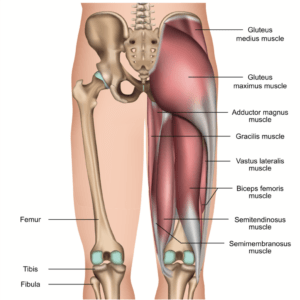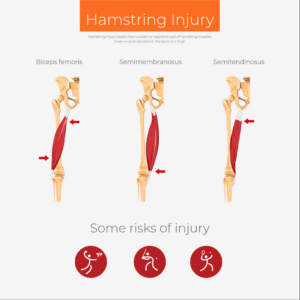Hamstring Tendinopathies – A frustrating injury however there is a pathway to normality
Introduction to Hamstring Tendinopathies
So you have been suffering from a hamstring injury. It has been a slow process and you still don\’t seem to quite be able to return to your previous activities fully, it teaks and twinges and still stops you from training normally. Why is your return to sport being affected so much by this injury? What do you need to do to get back to enjoying the activities and sports you are missing?
The key is to understand the injury, the factors that create the problem in the first place which affect the recovery phase. Understanding the cause and then the injury itself will help you build confidence in following the process fully to get the best results, not just recovery but prevention of future injury. Then when you are following the three main steps of recovery you will understand the process and can obtain the best results from your pathway back to sport. Finally there should always be other options, not everyone will follow the normal pathway so what are your other options should progress not follow the planned pathway?

Hamstring Injury – The Cause
There are three basic reasons that you have a hamstring tendinopathy. Unfortunately they are all related in a cascade of events that hamper the recovery process. However understanding these phases will help your recovery as you will be able to pin point where you are in the process.
- Repetitive Overloading – This would be the primary reason for hamstring tendon issues. Our neuromuscular system is working together to share the load and is always focused on one thing; completing the task in front of us. In an ideal world our body provides us with a number of different movement options to complete each task we undertake, however due to habitual postures, changes in training loads, repeated movement patterns you may start to lose some of these options. The hamstrings main focus should be on strength and speed activities, however if our core strength changes or our gluteals are not completing their task effectively the hamstrings can kick in to assist. This starts a simple process of overloading the hamstrings, which in turn over time can create tension in the system. The end result is that our hamstrings are working too hard too often and therefore are at increased risk of overloading the tendon. This type of issue tends to build up gradually over time although you may well notice an event that is the tipping point. Effectively that is the issue, the body is clever at hiding the problem until it is unable to do so any longer, and bang your pain begins.
- Specific Injury – This is a common cause of hamstring tendinopathies, however generally you will have bene building through option one prior to the actual injury. In this instance you will have a very specific point when the pain started, probably with no previous tightness or issues experienced. That doesn\’t mean that they were not building up in the background just that you had not noticed them, or not related changes in performance or flexibility directly to the building issue. So you will have experienced a specific injury event, maybe through running at top speed, sudden acceleration, kicking movements. The injury is different to a hamstring strain which will be in the belly of the muscle, this injury is high up in your thigh, deep in the gluts, almost on the sitting bone. It hurts, it is a deep ache, you can walk fine but there is an intense tightness present. This is going to be the musculo-tendon junction or your insertional tendinopathy.
- Previous Injury – Unfortunately one of the best predictors of an injury is a previous injury. So if you have had a previous hamstring tendinopathy then you are at risk of a repeat of the same problem, especially if the underlying causes were not addressed fully. In this instance generally the underlying factors that lead to your originally injury have built up in the background again, creating loading on the tissue and moving you towards a more degenerative tendon injury. The good news is that you can still resolve the issue however the time line will be extended due to the extra tendon loading that has been present.

What is Happening?
Simply speaking the tendon has been loaded excessively and there is a breakdown in the tendon collagen make up. This can be minor and resolve relatively quickly in acute instances, over with time other factors can come into play that require more complex rehabilitation programmes to resolve the problem. The tendon can revert to a weaker structure that will also have a neurovascular matrix potentially laid within the tendon structure. It can then be the compression caused by loading the tendon that creates the pain through stretching or compression of the nerve or blood vessels laid down within the tendon structure.
The tendons are primarily made up of mature tendon (tenocytes) that will have adapted to loading, and immature (tenoblasts) sections that are ready to develop and adapt. The theory is that when the tendon is loaded excessively the tenocytes are unable to cope and the immature tenoblasts create a healing process that may lead to this new matrix being set up within the tendon. However it is this process that can be used to our advantage in the recovery from the injury.
Three Steps to Recovery
There are essentially three phases that are considered for the rehabilitation of a tendon, the fourth would be rupture when orthopaedic, and possibly surgical, intervention are required. It will be very clear if this is the case so we will consider the main areas of rehabilitation that will concern your recovery.
- Reactive Phase – During this phase you will notice an ache generally deep ache that is easily irritated especially with loading. It maybe appropriate to obtain an MRI or US to assess the level of damage, and during this first phase the primary focus is on controlling the pain while building tissue tolerance again. This is a great time to review how the surrounding muscles are working, so for the hamstrings the gluteals and obliques are super important, with a focus on bilateral loading and isometric (static) work to help adaption. This phase will generally last from between 6-12 weeks with progressive increase in loading over this period and there is a good chance you can return to your chosen activity relatively quickly.
- Disrepair Phase – During this phase the pain can be more variable, and you need to consider that as part of your training progression. There will be points when you need to slow down or do less to manage the long term progress, although the pain should not be as irritable now. During this phase you will push into the pain, and that is an important part of the tendon adaption that is required for a good long term result. It is important to assess the local joints, so the hip, back and pelvis are very important in the initial phase along with the range of muscles around these joints too. It is good to begin muscle synergy training again so that the muscles are working together more effectively, while you will transition across to single leg training and loading, and for the younger athlete you may consider super max loading in gyms to help tendon adaption. This phase will generally last between 10-12 weeks however can be slightly longer.
- Degenerative Phase – These clients are likely to be 40+ years of age and the pain levels will have stabilised, while the problem will have bene present for a minimum of 6 months by this point. It is super important to kick start the healing process again for the tissues involved. At all stages the neural system can be assessed however now it is a really important step for the long term results, which can take anything from 6 months to 2 years to achieve. To get the healing process started again you will be guided to undertake heavy eccentric loading, super max loading which are aimed at disrupting the neurovascular matrix in the tendon and building tissue tolerance for the tenoblasts so they adapt into strong tendon.
What Else & Conclusion
Through a controlled programme of progressive loading and muscle training strategies you can get back to the activities you enjoy. Please be aware that this is not always a smooth journey and occasionally you need to take a step back to help you move forwards, with pain being a strong guide to the rate of progress.
There are other options to help if your rehabilitation hits a sticking point. At BLH the team have the ability to undertake shockwave treatment, which can really help get your hamstring tendinopathy moving forwards again. Please check our shockwave page to find out more details if you feel you are stuck and need to try a new option to kick start.
The key message to take away is that you can settle your hamstring tendinopathy down and get back to the sports and activities you enjoy. However to achieve the best results and make sure you change the stress on the hamstring long term it is worth spending the time and effort to put the best pathway in place for you, that includes making sure your muscles are working together effectively and undertaking the roles they are best designed to complete. Getting a clear plan in place and following the structure will help you achieve your goals
Build A Stronger Hamstring